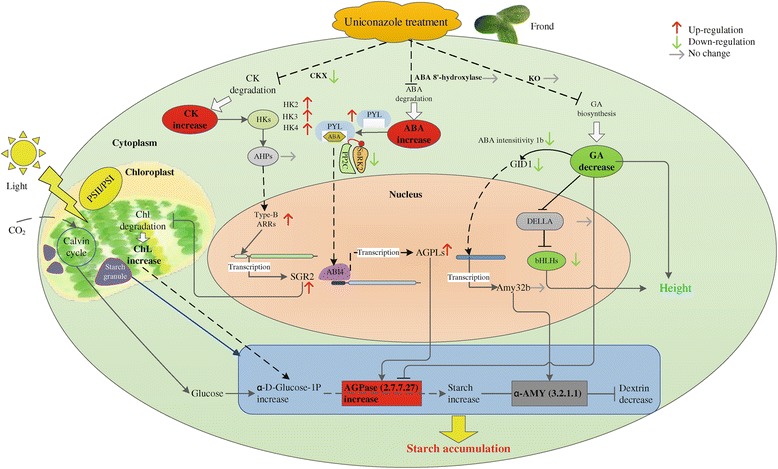Figure 5.

A hypothetical model of cytokinin, abscisic acid, and gibberellin signal pathways related to carbohydrate metabolism. Red indicates up-regulated expression, green down-regulated gene expression, gray means no significant difference was observed, and white means this enzyme was not found in this study. The major signaling pathways are indicated by black lines and arrows. Dotted arrowed lines indicate indirect or unconfirmed connections. Blue arrow indicates enlarged image. Cytokinin is perceived by the cytokinin receptor HKs. Cytokinin binding to HKs activates autophosphorylation (P) via AHPs (histidine phosphotransfer proteins) in the cytoplasm. Then type-B Arabidopsis thaliana response regulator (type-B ARR) interacts with the promoter of STAY-GREEN2 (SGR2). The family of START proteins (PYLs) act as ABA receptors. ABA combines with intracellular PYL and type 2C protein phosphatase (PP2C) to form an ABA-PYL-PP2C complex. This complex inhibits the activity of PP2C in an ABA-dependent manner and activates SNF1-related protein kinase 2 families (SnRK2s). Abscisic acid insensitive 4 (ABI4) induces ADP-glucose pyrophosphorylase subunit AGPLs (ApL3) gene expression. The main components of the GA signal pathway include GA receptor (GID1) and DELLA growth inhibitors. The GA-GID1-DELLA complex stimulates the degradation of DELLAs to regulate plant growth. GID1 regulated the transcription of amylase by a number of transcriptional regulatory.
